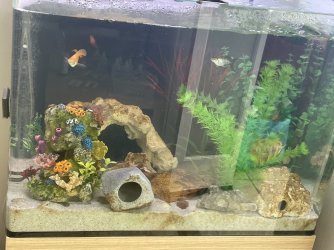JoeFinn1997
New Member
Hello,
I’ve completed a fish in cycle (I didn’t realise this was bad due to poor advice from the store). My ammonia and nitrite readings are consistently 0 and my nitrates are kept below 50 with water changes when necessary.
However, it seems I am having more problems with fish health now the tank is cycled than while I was completing the fish in cycle. My fish are hiding a lot of the time, although still eating, and also I have lost two fish who seemed completely fine during the cycle and then went quickly downhill after the cycle.
I am just wondering what I can do to prevent further losses and is there anything further I need to check on the tank.
For reference, my tank is 100 litres and I originally had 8 Livebearers. 4 platy and 4 mollies. I have lost 1 of each fish so far. I only have artificial decorations and no live plantation.
From my understanding, the fish listed above are supposed to be ‘hardy’ fish. Therefore, if my main water parameters(ammonia, nitrite and nitrate) are consistently fine then I have no idea what is causing the issue. I have plenty of surface movement and also an air stone.
Any thoughts/advice would be much appreciated.
Thanks
I’ve completed a fish in cycle (I didn’t realise this was bad due to poor advice from the store). My ammonia and nitrite readings are consistently 0 and my nitrates are kept below 50 with water changes when necessary.
However, it seems I am having more problems with fish health now the tank is cycled than while I was completing the fish in cycle. My fish are hiding a lot of the time, although still eating, and also I have lost two fish who seemed completely fine during the cycle and then went quickly downhill after the cycle.
I am just wondering what I can do to prevent further losses and is there anything further I need to check on the tank.
For reference, my tank is 100 litres and I originally had 8 Livebearers. 4 platy and 4 mollies. I have lost 1 of each fish so far. I only have artificial decorations and no live plantation.
From my understanding, the fish listed above are supposed to be ‘hardy’ fish. Therefore, if my main water parameters(ammonia, nitrite and nitrate) are consistently fine then I have no idea what is causing the issue. I have plenty of surface movement and also an air stone.
Any thoughts/advice would be much appreciated.
Thanks




